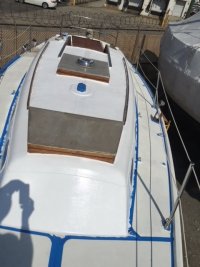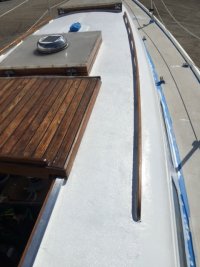Hey guys, my 1971 Ericson 32 has soft spots around the hatch due to leaks of the same....what is the best option for repairs? Has anybody done this before? My idea is to cut the inner roof com[pletely out, remove the rotten foam(is it foam sandwich?) and replace it and then fibreglass it with two layers, also from the inside....Any ideas??
You are using an out of date browser. It may not display this or other websites correctly.
You should upgrade or use an alternative browser.
You should upgrade or use an alternative browser.
Soft spots on cabin roof 1971 Ericson 32
- Thread starter hotinja
- Start date
During the rehab of my recently acquired 1974 32, I tackled the problem from the outside on top of the cabin. I determined the area I wanted to remove, marked out the area with a marker, drilled 4 holes at the corners. I used a jigsaw with adjustable depth plate (to make sure I didn't cut too deep) and metal saw blade to cut out the area. I kept the old fiberglass area I removed, scraped off the underside clean. Mine had soaked balsa core that I removed, let the area dry out. I then epoxied a layer of fiberglass mat and a layer of biaxial. I added new balsa core, added another layer of the biaxial fiberglass, then epoxied the old area back to the area. I placed weights on top of the area. Once dried, I used fairing compound along the cut area, let it dry and then sanded the area. I did 4 areas around both hatches. 3 day project. I have attached pictures of finished areas.
Attachments
In my opinion this is one of those projects that defines commitment to your boat. It's a big job and profits from experience in working with the materials and tools involved. Lots of 1971 boats have soft decks and are sold and sailed as is.
Makes sense if you plan to keep the boat for years and restore it over time. And yeah, lots of us here in that category.
Makes sense if you plan to keep the boat for years and restore it over time. And yeah, lots of us here in that category.
HerbertFriedman
Member III
I had a similar problem around the cabin top near the sissy bars at the mast. The soft spot was about 12x12 inches. I was lucky to be able to unbolt the sissy bar and cut a two inch diameter hole. then I was able to fish out all the water soaked balsa core with a hooked wire. When all clear, it used a hair drier to dry out the core for about a full day. Then the yard hunted up some very slow curing epoxy mix, they wanted to avoid excess heat during the cure period. I had they squirt in the eposy mix with a " grease gun" using an empty cartridge filled with the epoxy. They pumped in the epoxy until it overflowed the holes. I finished off the two inch hole and bolted back on the sissy bar. No need to match the non skid pattern, the base of the sissy bar covered the hole. But even if you dont have a 2 inch hole, you could cut out a one to two inch piece of the top skin, and do the same, assuming that the soft area is not large.
tenders
Innocent Bystander
I've done a ton of core repair on my 69 E32. Seems like I end up doing a section every couple seasons, including the cockpit floor, the port side deck, the entire mast step (which seemed like a terrifying job at the outset), and the area around the hatch (which also involved a hatch removal, rebuild, and remount). Unfortunately I didn't document the hatch area fix but I did my best on the other three.
The key elements of my approach:
* repair from the top, do not fight gravity
* cut top deck off with an oscillating saw, which is also useful for digging out old-but-not-yet-rotten core
* bevel edge of remaining deck 2"
* replace balsa core with foam core, not to be confused with spray foam
* replace deck with 3/16" G10, with 2" beveled edge
* join resulting seam with 4-3-2-1" layers of fiberglass cloth and epoxy
* fair and finish (paint/Kiwi Grip)
 ericsonyachts.org
ericsonyachts.org
 ericsonyachts.org
ericsonyachts.org
The key elements of my approach:
* repair from the top, do not fight gravity
* cut top deck off with an oscillating saw, which is also useful for digging out old-but-not-yet-rotten core
* bevel edge of remaining deck 2"
* replace balsa core with foam core, not to be confused with spray foam
* replace deck with 3/16" G10, with 2" beveled edge
* join resulting seam with 4-3-2-1" layers of fiberglass cloth and epoxy
* fair and finish (paint/Kiwi Grip)
1969 E32 cockpit core repair: an illustrated guide
E32 cockpit core repair: an illustrated guide The cockpit deck of my fine 32, built in 1969, owned and sailed by me since 1991 on three US coasts (west, north, and east), had become progressively spongier and spongier; I think the area around the fuel fill had leaked water long ago. My boat...
Moyer Marine Atomic 4 Community - Home of the Afourians
Moyer Marine Inc. Parts and Services for the Universal Atomic 4 Engine
www.moyermarineforum.com
Seeking advice on E32 mast step repair
E32 mast step deck repair: an illustrated guide My 1969 Ericson 32, which I've owned since 1991, has a deck-stepped mast. Under the mast, just a bit to port of the centerline, is a mahogany compression post, and about 18” to the right of this is another mahogany post of somewhat less...
Mr. Scarlett
Member III
I like this idea, but did you ever try to save and use the old skin? I had success doing it on another boat with areas as large ad 12 X 24"replace deck with 3/16" G10
tenders
Innocent Bystander
The skins I’ve ended up peeling off were chipped, cracked, crazed, flexed to the point of flimsiness, of irregular thickness, and with worn nonskid. In any event they would have required a lot of time to get into shape for reinstallation. The knocks on G10 are that it requires a carbide blade to cut, and that it is expensive. But that G10 strength and hardness is a huge plus once it’s installed, and an additional $20/square foot of cost pales in comparison to the value of the amount of time that goes into these types of repairs - or is saved by not having to refurbish old skin.
G10, how do I love thee? Let me count the ways.
G10, how do I love thee? Let me count the ways.
A wet tile saw works wonders on G10.requires a carbide blade to cut
tenders
Innocent Bystander
Oh, get a load of Mr. Fancy Pants over there, with a wet tile saw - the Grey Poupon of specialty tools!A wet tile saw works wonders on G10.
(Yeah, I can see how that would work very well too.)
Hah! In all fairness when I had that inspiration I happened to have rented a tile saw for a concurrent bathroom remodel while I was doing some G10 work on the boat. Just one more reason my boat projects take forever.the Grey Poupon of specialty tools!
kapnkd
kapnkd
Around the main companionway on our ‘73 E-33, water intrusion inevitably got into the space between the two sliding rails.I like this idea, but did you ever try to save and use the old skin? I had success doing it on another boat with areas as large ad 12 X 24"
We cut the center section (carefully) out from above, saved the piece and glassed it back in place again after restoration of the rotted old core.
For sure, there was a clear cosmetic line to be reckoned with! We knew this and created/crafted a functional fiberglass hatch cover to cover the overall area and keep future waters from so easily seeped in.
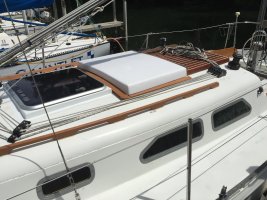
We trimmed around it with “PlasTeak” to match the hand rails and ease of upkeep.
(It also keeps crew off the hatch when on deck.)
Another good option for cutting G10 is jig saw blades for fiber cement board:
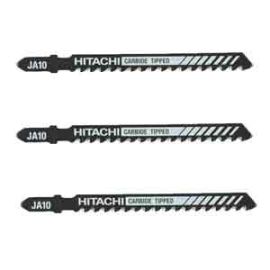
 www.toolorbit.com
www.toolorbit.com
G10 is great for high load areas like winches or other deck hardware or sealing deck penetrations like this one for a bulkhead heater chimney
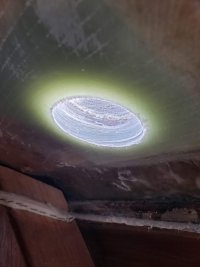
It kind of defeats the purpose of a light weight core if it's used to replace everything Your deck would be bulletproof though.

Hitachi 725397 4 Inch 6 TPI HCS Fiberglass-Reinforced Plastic Cutting Jig Saw Blades (3 Pk)
Hitachi 725397 4 Inch 6 TPI HCS Fiberglass-Reinforced Plastic Cutting Jig Saw Blades (3 Pk). Fast Coarse Cutting in Abrasive Materials; FRP 1/4 Inch to 3/4 Inch; Cement Bonded Particle Board 1/4 Inch to 2-3/8 Inch; Fiber Cement (HardiBoard). Get FREE SHIPPING on selected Hitachi tools and...
G10 is great for high load areas like winches or other deck hardware or sealing deck penetrations like this one for a bulkhead heater chimney

It kind of defeats the purpose of a light weight core if it's used to replace everything Your deck would be bulletproof though.
tenders
Innocent Bystander
Interesting - I haven't noticed carbide-tipped jigsaw blades before. My beef with jigsaws though is that the blades are subject to distraction and often don't cut perpendicular to the surface. This is an annoyance both for the piece being cut out, and for the quality of the edge left in the remaining raw material for the next project. It is also entirely possible that I simply suck at jigsaw, though.
G10 makes sense as a core material in small sections of deck that will be under compression - for example, under stanchions and winches (as trickdhat points out), where plywood was often used during original construction in place of the balsa used elsewhere. G10 is far too expensive, heavy, and counter to the engineering tenets of "sandwich" construction to use as a core on a large scale.
I don't know anything about chimney considerations, but in trickdhat's chimney hole above, it would seem to me that the quality of the G10 installation would be its watertightness, which is dependent on the integrity of the seal between the G10 and the stuff above it. This would be the case if the G10 were simply foam, too, though there's certainly nothing wrong with a few square inches of good old-fashioned overkill.
G10 makes sense as a core material in small sections of deck that will be under compression - for example, under stanchions and winches (as trickdhat points out), where plywood was often used during original construction in place of the balsa used elsewhere. G10 is far too expensive, heavy, and counter to the engineering tenets of "sandwich" construction to use as a core on a large scale.
I don't know anything about chimney considerations, but in trickdhat's chimney hole above, it would seem to me that the quality of the G10 installation would be its watertightness, which is dependent on the integrity of the seal between the G10 and the stuff above it. This would be the case if the G10 were simply foam, too, though there's certainly nothing wrong with a few square inches of good old-fashioned overkill.
fixntheboat
Member II
That looks great. I recently purchased a 73 E32-2 ,and am doing a complete refit. Both of these hatches are coming out. I would be interested in more info/photos on this project. also the make on skylight hatch. other rigging looks good as well. lots of ideas for me here thanks!Around the main companionway on our ‘73 E-33, water intrusion inevitably got into the space between the two sliding rails.
We cut the center section (carefully) out from above, saved the piece and glassed it back in place again after restoration of the rotted old core.
For sure, there was a clear cosmetic line to be reckoned with! We knew this and created/crafted a functional fiberglass hatch cover to cover the overall area and keep future waters from so easily seeped in.
View attachment 44486
We trimmed around it with “PlasTeak” to match the hand rails and ease of upkeep.
(It also keeps crew off the hatch when on deck.)
it also has a leak at the hatch so it definitely needs to repair. don't you think it's safety risk to have a soft deck? I was told, in a storm, it can blow off, no idea if it actually happened..In my opinion this is one of those projects that defines commitment to your boat. It's a big job and profits from experience in working with the materials and tools involved. Lots of 1971 boats have soft decks and are sold and sailed as is.
Makes sense if you plan to keep the boat for years and restore it over time. And yeah, lots of us here in that category.
nice job!During the rehab of my recently acquired 1974 32, I tackled the problem from the outside on top of the cabin. I determined the area I wanted to remove, marked out the area with a marker, drilled 4 holes at the corners. I used a jigsaw with adjustable depth plate (to make sure I didn't cut too deep) and metal saw blade to cut out the area. I kept the old fiberglass area I removed, scraped off the underside clean. Mine had soaked balsa core that I removed, let the area dry out. I then epoxied a layer of fiberglass mat and a layer of biaxial. I added new balsa core, added another layer of the biaxial fiberglass, then epoxied the old area back to the area. I placed weights on top of the area. Once dried, I used fairing compound along the cut area, let it dry and then sanded the area. I did 4 areas around both hatches. 3 day project. I have attached pictures of finished areas.
safety risk to have a soft deck...in a storm?
We should all avoid storms, but short of that, I consider soggy deck core to be just one of those things. Depends the square footage I guess, but as a danger, pretty low in my opinion. Mostly just a fix project loyal owners feel obliged to undertake.
We should all avoid storms, but short of that, I consider soggy deck core to be just one of those things. Depends the square footage I guess, but as a danger, pretty low in my opinion. Mostly just a fix project loyal owners feel obliged to undertake.
kapnkd
kapnkd
Good points Christian.safety risk to have a soft deck...in a storm?
We should all avoid storms, but short of that, I consider soggy deck core to be just one of those things. Depends the square footage I guess, but as a danger, pretty low in my opinion. Mostly just a fix project loyal owners feel obliged to undertake.
I’ve never once EVER feared for the overall integrity or strength of the cabin trunk - but - yet knowing there were issues - left me/us with a gnawing feeling it should be properly addressed and resolved, which we chose to do.
(Besides, those nagging slow drips that insisted on soaking various cushions during heavy rains was a hard and true incentive!)
ALAS! …ALL of us owner’s personal pride in ownership of ANY boat/vessel resides in it being maintained in traditional “Bristol Fashion”, which we want others especially hope to appreciate and admire. …After all, it IS a clear reflection of our own seamanship, skills and abilities.
AND - this is all easily tied more tightly together for those of us owning the older classic ERICSON’s ;-)
tenders
Innocent Bystander
I’ve had no regrets repairing the deck sections I’ve recored. Each became spongy due to leaks that needed to be fixed. The sponginess underfoot was extremely unsettling. And the top layers of the fiberglass sandwiches I’ve removed had flexed materially over many years and not been structurally sound; eventually, they would have given way. The lower layer of the fiberglass sandwich is far less substantial so I can see these issues becoming structural failure points at a most inconvenient time.


